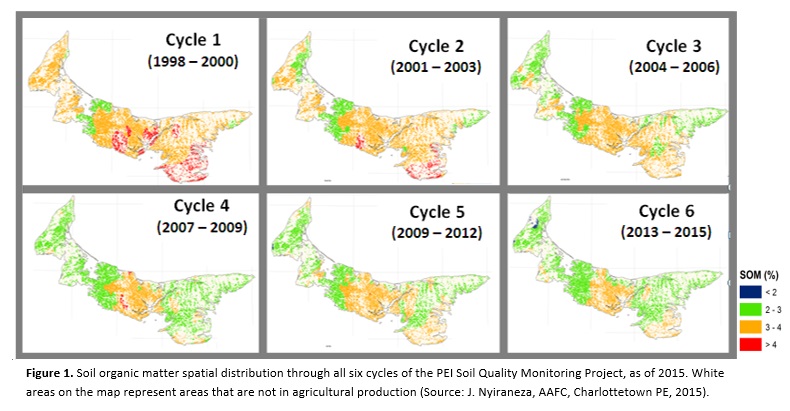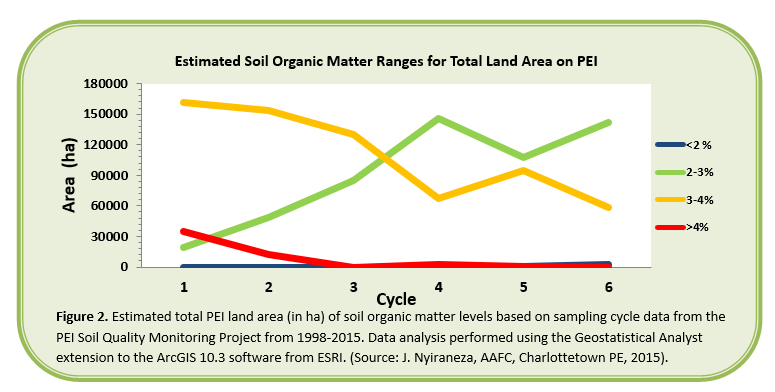Soil Organic Matter Status on PEI
Soil organic matter (SOM) is the main building block for many chemical, physical and biological factors of a soil. Sufficient levels of soil organic matter are a necessity to ensuring productive and healthy soils. Agricultural soils with high soil organic matter levels are crucial in maintaining soil and crop productivity, as well as providing greater resilience to environmental conditions like wind and water erosion, high precipitation events, flooding and droughts. Soil organic matter is also essential in producing high yielding and superior quality crops. Soil organic matter is often associated with many other benefits including:
- better physical structure, providing a better medium for plant growth
- less prone to surface and subsurface compaction
- increasing soil water holding capacity (beneficial during drought events)
- increasing water infiltration rate (beneficial during high precipitation events, snow melts)
- better nutrient holding capacity
- providing nutrients to crops throughout the season as organic residues decompose and mineralize
- allowing for easier cultivation with greater tilth and aggregate stability (soil is less prone to clodding)
Soil OM is compromised of three main groups:
- stable fraction (often referred to as “humus”)
- live fraction
- actively decomposing fraction.
The humus fraction is an extremely stable form of organic matter that has been developed over tens to hundreds of years and is comprised of fully decomposed tissues. Nutrients and minerals within this fraction are generally unavailable to plants given their stable form which can take a long time to decay and mineralize, however, the humus plays a large role in many soil physical characteristics.
The “live” fraction of organic matter refers to the many living organisms that live within the soil such as bacteria, fungi, algae, actinomycetes, earthworms, nematodes, and arthropods that are actively feeding and recycling nutrients in plant available forms. These living organisms are the decomposers of plant residues, root tissues and other plant matter fractions that accumulate in the soil and contribute to improving the active organic matter levels within the soil.
The actively decomposing fraction refers to the plant residues, dead organisms, fungal and root tissues that are being decomposed. This is the fraction of the soil that generally supplies the soil with plant available nutrients and breaks down large plant residues.
Since 1998, the PEI Department of Agriculture and Fisheries has been monitoring changes in soil organic matter levels across the Island in a long-term Soil Quality Monitoring Project. Since the beginning of this project, organic matter levels have shown a decline Island wide, with some areas showing more aggressive declines than others (Figure 1). Overall, total area on PEI in the range above 4% and between 3-4% SOM has decreased, whereas the area in the range between 2-3% SOM has increased (Figure 2).


It is difficult to build and maintain soil organic matter on PEI due to a combination of factors. Most of the soils on PEI are well drained, coarse, sandy loams that are often very fertile; but PEI’s humid climate, in combination with undulating topography, favour soil erosion thus transporting fine soil particles rich in organic carbon. Agriculture is an economically important activity in PEI involving a high level of inputs and outputs per unit of land resulting in frequent soil tillage and accelerated soil organic matter mineralization. Additionally, there has been a reduction in the availability of soil amendments and manures for use (caused by a decrease in livestock operations) on PEI. It is crucial to maintain high SOM levels in order to ensure that our soils will be able to hold nutrients and water for our crops.
In order to reverse the trend of decreasing organic matter levels within PEI soils, best management practices (BMP) should be implemented.
PRACTICES THAT CAN HELP BUILD OR MAINTAIN ORGANIC MATTER
- Additions of livestock manures, green manures, and soil amendments to fields
- Reduce the amount of primary and secondary tillage operations as much as possible
- Incorporate forages and grasses into rotations, and maintain growth throughout rotation as long as possible
- Keep soil covered during the winter months by delaying time of plowing and using cover crops following row crop harvest
- Maintain living roots as long as possible within the rotation to promote soil microbial activity
- Minimize use of fall tillage, but when necessary, use conservation tillage techniques late in fall to keep crop residues on soil over the winter to mitigate soil erosion and runoff
- Increase use of nurse crops or companion crops during the growing season of row crops to decrease soil erosion
To discuss implementation of these BMP’s on your farm, please contact:
PEI Department of Agriculture and Land
Phone: (902) 316-1600
E-mail: kstiles@gov.pe.ca
Access the full PEI Soil Quality Monitoring Report on-line.
An updated version of the SQM report will be available in early 2017.
This factsheet was prepared by Kyra Stiles (Sustainable Agriculture Resource Section of the PEI Department of Agriculture and Fisheries), and Judith Nyiraneza (Charlottetown Research and Development Centre of Agriculture and Agri-Food Canada).